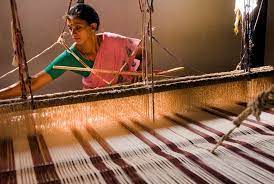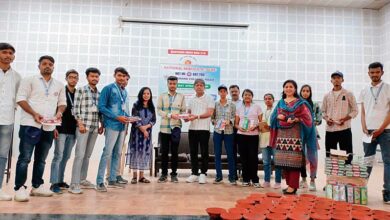In the midst of fast fashion, let’s embrace conscious choices on National Handloom Day in 2023
The handloom has become a lasting emblem of sustainability and cultural history in the ever-evolving fashion business. National Handloom Day, observed on August 7th, honors India’s rich handloom heritage and serves as a somber reminder of the historic appeal to promote indigenous goods made during the Swadeshi movement, which got its start on this day in 1905. The handloom is the pinnacle of thoughtful consumerism and ageless workmanship because of its resistance to significant upheavals, including the fast-fashion period.
The history of Indian handloom weaving is rich in artistry and cultural importance. Skilled weavers have infused their hearts and souls into every thread for millennia, producing textiles that capture the spirit of our many cultures and creative expression. Slow and conscientious fashion has become more important in the modern day. Handloom goods are becoming more well-known and popular as ethical customers become more aware of how their decisions affect the environment and society. Slow fashion, which emphasizes sustainability, workmanship, and conscious consumerism, perfectly complements the tenets of handloom goods.
“As sustainability and conscious consumption pick up steam, the handloom sector has emerged as the go-to option for ethically made, environmentally friendly, and culturally significant textiles. Being made from natural fibers with less of an effect on the environment and using a low-energy, low-water technique, handloom items naturally reflect sustainability and eco-friendliness, making them a greener option to industrialized textile manufacturing. According to Sreya Samanta, textile designer and the founder and creative director of Label Sreya Samanta, “the admiration for the distinctiveness and artistry of handloom textiles further increases the allure of conscientious consumers towards this timeless legacy.
In light of the prevalent fast fashion culture, National Handloom Day serves as a timely reminder to turn our attention to deliberate decisions. Handlooms are a representation of culture, creativity, and ethical fashion.
Debaroopa Bhattacharya, creator of the sustainable company Ummaira, emphasizes the importance of making conscious decisions, stating that “the handloom sector has experienced a dramatic change towards being the preferred option of conscious persons seeking ethically-produced textiles. Despite having difficulty paying bills and having few people aware of government programs, recent efforts have shown encouraging outcomes. The government has put in place programs and infrastructure to help weavers who make less than 5,000 per month, but awareness is still at a pitiful 17%.
A network of handloom institutions has been offered as a solution to this problem, giving weavers personal identification and serving as a point of contact for government e-commerce platforms, opening up access to a larger market. Additionally, these institutions provide design and training assistance, encouraging the entrepreneurial spirit and inventiveness of weavers. The handloom business is setting the way for environmentally friendly and culturally relevant textiles that resonate with the ideals of conscientious customers by closing the knowledge gap, providing financial facilities, and fortifying the supply chain, says Bhattacharya.
Choosing handloom clothing is a conscious move in the direction of ethical fashion. Each piece of handwoven art has a unique narrative that reflects the commitment of the craftsmen and years of skill development. “Handloom goods are not only good for the skin, but also have a sustainable influence on the environment and economy because to essential characteristics like durability, a distinct hand-feel, and the use of natural fibers like cotton, wool, and silk. Consider the handwoven Kala Cotton fabric, which becomes softer and whiter with each wash and offers relief and comfort in a variety of weather situations. According to Matrika Bhandari, co-founder of Inkriti, “The handloom industry’s dedication to sustainability not only helps to a cleaner environment but also plays a key role in producing employment for rural India.
Handlooms are a representation of culture, creativity, and ethical fashion. Adopting handloom items shows a dedication to conserving traditional skills, assisting local people, and protecting the environment in a world when short turnarounds and mass manufacturing are the norm.
Brands are changing how consumers interact with clothing and having a positive influence on the fashion industry.
It is an honor for Fabindia, a well-known sustainable brand, to be a part of such a long tradition. For Fabindia, National Handloom Day is very important since it supports our fundamental beliefs of fostering sustainable livelihoods and safeguarding India’s cultural heritage. Indigenous weaves, patterns, and colors that have been passed down through the generations capture the broad and vibrant character of the real India.
By working with talented weavers and craftspeople, Fabindia has always been devoted to helping the many artisan communities in India. Over 55,000 rural craft-based producers have now been effectively linked to contemporary metropolitan markets, laying the groundwork for skilled and long-lasting rural employment while maintaining India’s traditional handicrafts. Their handloom goods, which range from elaborately woven sarees to chic contemporary clothing, are anchored in history while also catering to current preferences. One such classic comes from our cluster in Chanderi, Madhya Pradesh. The artists there weave pure silk, Chanderi cotton, and silk cotton on traditional floral and peacock themes and contemporary geometric designs to produce lovely saris for our clients.
Locally produced companies like Vilasa believe that handloom is witnessing a comeback due to the recovery of consumer desire for slow, authentic handmade goods and the growth of tiny, indigenous labels supporting sustainability. With its economical but beautiful hand woven marvels like Jamdanis, Murshidabadi silks, and Chanderis, Vilasa, a sustainable handloom business, is at the vanguard of this trend, bridging the gap between distant weavers and middle-class customers. This business is dispelling the myth that handcrafted items are expensive and demonstrating that slow fashion can be affordable without sacrificing its integrity, paving the path for a better and more sustainable future for handloom.
A key problem in the handloom industry is the seeming shortage of weavers who are presently engaged in their trade. Despite the Department of Handlooms and Textiles’ attempts to provide policies and programs to revitalize the industry, some weavers still have little knowledge of these options. To guarantee the long-term development of the handloom industry, it is essential for prospective weavers to be well-informed about the assistance and financing choices that are available. Adopting responsible fashion becomes more important as we go toward revitalizing the handloom industry. Consumers may help preserve traditional craftsmanship, empower talented craftsmen, and promote a sustainable future for the industry by actively supporting and promoting handloom items.







